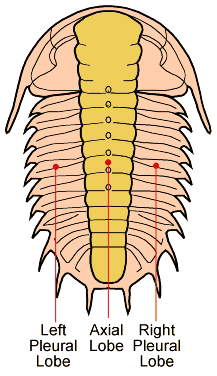
©1999 by S.M. Gon III The trilobite body is divided into three tagmata (major sections), a cephalon with eyes, mouthparts and antennae,
a thorax of multiple articulated segments (that in some species allowed
enrollment), and a pygidium,
or tail section of fused segments.
|
 The name "trilobite" (meaning "three-lobed")
is not based on the tagmata (cephalon, thorax, and pygidium), but on the three longitudinal lobes: a central axial lobe, and
two pleural lobes that flank the axis.
|

When describing differences between different taxa
of trilobites, the presence, size, and shape of the cephalic features above
are often mentioned. To the right are cephalic (cranidial) features described when the librigenae are missing.
|
.....
The cheeks (genae) are the pleural lobes on each
side of the axial feature, the glabella. When trilobites molt or die, the
librigenae (the so-called "free cheeks") often separate along the facial sutures, leaving only the cranidium --that is, the glabella and fixigenae ("fixed cheeks").
|



